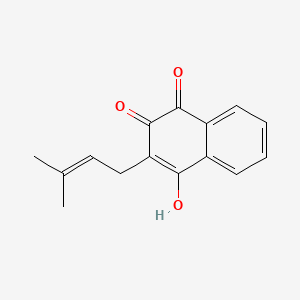D0975 | lapachol
| Toxicity | Dose | Time | Species | Model | Method | Action | Positive criterion | Reference |
|---|---|---|---|---|---|---|---|---|
| MEMBRANE POTENTIAL | 26.12±1.70 | human | qHTS-HepG2 | MMP assay | decrease | IC50 | 163 | |
| MEMBRANE POTENTIAL | 31.62 | human | HepG2 | MMP assay | decrease | IC50 | 163 | |
| MEMBRANE POTENTIAL | rat | hepatocytes | MMP assay | Negative | IC50 | 163 | ||
| Pictogram | Signal | Statements | Precautionary Statement Codes |
|---|---|---|---|
 |
Warning |
Aggregated GHS information provided by 39 companies from 1 notifications to the ECHA C&L Inventory. Each notification may be associated with multiple companies. H302 (100%): Harmful if swallowed [Warning Acute toxicity, oral] H312 (100%): Harmful in contact with skin [Warning Acute toxicity, dermal] H315 (100%): Causes skin irritation [Warning Skin corrosion/irritation] H319 (100%): Causes serious eye irritation [Warning Serious eye damage/eye irritation] H332 (100%): Harmful if inhaled [Warning Acute toxicity, inhalation] H335 (100%): May cause respiratory irritation [Warning Specific target organ toxicity, single exposure Respiratory tract irritation] Information may vary between notifications depending on impurities, additives, and other factors. The percentage value in parenthesis indicates the notified classification ratio from companies that provide hazard codes. Only hazard codes with percentage values above 10% are shown. |
P261, P264, P270, P271, P280, P301+P312, P302+P352, P304+P312, P304+P340, P305+P351+P338, P312, P321, P322, P330, P332+P313, P337+P313, P362, P363, P403+P233, P405, and P501; (The corresponding statement to each P-code can be found at the GHS Classification page.) |
| 1, 2-hydroxy-3-(3-methyl-2-butenyl)- | 1,4-Naphthalenedione, 2-hydroxy-3-(3-methyl-2-butenyl)- | 1,4-Naphthalenedione, 2-hydroxy-3-(3-methyl-2-butenyl)- (9CI); |
| 1,4-Naphthalenedione,2-hydroxy-3-(3-methyl-2-buten-1-yl)- | 1,4-Naphthoquinone, 2-hydroxy-3-(3-methyl-2-butenyl)- | 2-Hydroxy-3-(3-methyl-2-butenyl)-1,4-naphthalenedione |
| 2-Hydroxy-3-(3-methyl-2-butenyl)-1,4-naphthoquinone | 2-Hydroxy-3-(3-methyl-2-butenyl)naphthoquinone # | 2-Hydroxy-3-(3-methylbut-2-enyl)-1,4-naphthoquinone |
| 2-hydroxy-3-(3-methyl-2-butenyl)-1,4-naphtho-quinone | 2-hydroxy-3-(3-methylbut-2-enyl)naphthalene-1,4-dione | 3-(3-Methyl-2-butenyl)-4-hydroxy-1,2-naphthoquinone |
| 4-08-00-02487 (Beilstein Handbook Reference) | 4-hydroxy-3-(3-methylbut-2-enyl)naphthalene-1,2-dione | 4CN-0974 |
| 84-79-7 | AB1010137 | AC-8971 |
| ACN-036176 | AK168089 | AKOS015951424 |
| AKOS032948320 | AS-35308 | B221938VB6 |
| BCP24022 | BRN 2051889 | BSPBio_002416 |
| Bethabarra wood | C.I. 75490 | C.I. Natural Yellow 16 |
| C10366 | CAS-84-79-7 | CCG-35464 |
| CCRIS 745 | CHEBI:6377 | CHEMBL15193 |
| CI75490 | CIEYTVIYYGTCCI-UHFFFAOYSA-N | CTK5F3159 |
| Cancer Chemother Rep (part 2) 4: 11 (1974) | DSSTox_CID_29390 | DSSTox_GSID_49430 |
| DSSTox_RID_83505 | DTXSID6049430 | DivK1c_000594 |
| EINECS 201-563-7 | FT-0649649 | Greenharten |
| Greenhartin | HMS1921B06 | HMS501N16 |
| IDI1_000594 | IPE-tobacco wood | KBio1_000594 |
| KBio3_001636 | LS-95648 | Lapachic acid |
| Lapachol wood | Lapachol, 98% | MCULE-9211486718 |
| NCGC00094931-01 | NCGC00094931-02 | NCGC00094931-03 |
| NCGC00094931-04 | NCGC00260494-01 | NCI60_000457 |
| NCI60_000587 | NCIMech_000076 | NINDS_000594 |
| NSC 11905 | NSC 11905 | NSC 629756 |
| NSC-11905 | NSC-11905 | NSC-629756 |
| NSC11905 | NSC11905 | NSC629756 |
| Natural Yellow-?16 | Oprea1_717083 | Q739601 |
| SC-91848 | SCHEMBL157255 | SCHEMBL157256 |
| SDCCGMLS-0066666.P001 | SPBio_001341 | SPECTRUM1501204 |
| SR-05000002489 | SR-05000002489-1 | Spectrum2_001451 |
| Spectrum3_000768 | Spectrum5_001873 | Surinam greenheart wood |
| Taigu wood | Taiguic acid | Tecomin |
| Tecomin (VAN) | Tox21_202948 | UNII-B221938VB6 |
| W2146 | WLN: L66 BV EVJ CQ D2UY1&1 | ZINC3873071 |
| ZINC78934733 | Zlut prirodni 16 | Zlut prirodni 16 [Czech] |
| bmse000989 | lapachol | s5684 |

